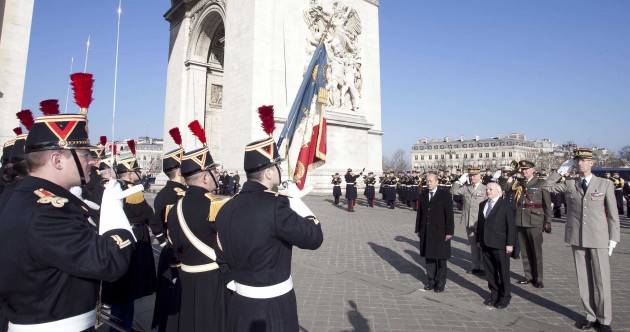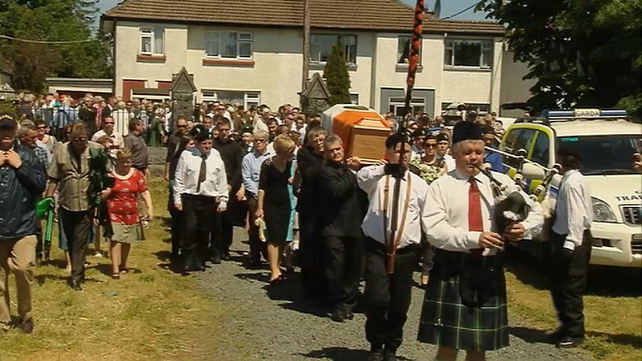President Michael D Higgins says Irish economy is recovering
IN A STATE VISIT TO CROATIA IRISH PRESIDENT LOOKS TO RECOVERY AND THE FUTURE, PRESIDENT MICHAEL D. HIGGINS HAS SAID THAT THE IRISH ECONOMY IS RECOVERING.
Irish President Michael D Higgins told a group of business leaders in Croatia this week that the Irish economy is recovering.
Speaking at an event in Zagreb aimed at developing Ireland’s economic links with Croatia, President Higgins made his remarks on the final day of his State visit.
According to RTE President Higgins told the audience of Irish and Croatian business people that the days of Ireland’s speculative economy are a thing of the Celtic Tiger past.
Instead the country is focusing on its sustainable and traditional businesses such as agriculture, tourism and services, he said.
Only $66 million a year is traded between Ireland and Croatia currently, but tourism and education are seen as potential growth areas between the two countries, especially after Croatia becomes part of the EU at the beginning of next month.
President Higgins is scheduled to stay in the country until Sunday. He will reportedly spend the next two days in the northern coastal area.
Alcohol abuse, drug abuse and mental illness feature in child care cases
ALCOHOL ABUSE, DRUG ABUSE AND MENTAL ILLNESS FEATURE IN MANY OF THE CASES PUBLISHED BY THE CHILD CARE LAW REPORTING PROJECT TODAY.
The latest tranche of child care cases published online by the project include children who have suffered physical and sexual abuse as well as non-accidental injury, at the hands of a parent or carer.
More than 30 cases are detailed in the report, at Child law project.ie, from all over the country, though locations have not been given to protect identities.
One case involved an interim care order granted for four African children whose “silent crying” worried a court appointed guardian. A second case involved a new-born baby of a drug addict being taken into care. The reports also detail two cases of English children taken into care in Ireland and how the English courts have been asked to take over their proceedings.
The publication is the second volume of reports from child care hearings in Ireland involving cases where the HSE sought to take children into care or supervise them in their homes. The cases are normally held in camera, excluding the press and members of the public. The reporting project was established in 2012 under the Child Care (Amendment) Act 2007 so that child care proceedings could be examined and reported on. Many of the cases reported today describe one or two hearings in a lengthy process.
The case reports show the courts are sometimes critical of the care children received from the HSE and the steps it has taken to meet their needs.
In one case the court only made a Full Care Order for five months because it was not satisfied that an adequate care plan had been drawn up for the child. In another case the court ordered the HSE to provide a special needs assistant for a child in order to help him integrate into his school, and in a third, the court ordered the HSE to provide speech and language therapy “forthwith” for a child who needed it.
Project director, Dr Carol Coulter said a further reports will be published during the year, along with relevant material on the child protection system.
“This is the second volume of case reports to be published by the Child Care Law Reporting Project and it shows that the problems highlighted in the first volume, of alcohol and drug abuse, mental illness and domestic violence, affect families in all parts of the country,” Dr Coulter said.
Only 50% of us Irish would call for ambulance after having a stroke


Just half the population would phone an ambulance immediately after a stroke attack, new research has revealed.
The Irish Heart Foundation (IHF) described the results of the study as alarming and insisted more lives could be saved if people reacted faster.
Head of advocacy at the charity Chris Macey said while more people now recognise the signs of a stroke, not enough take the right action.
“These statistics are alarming because there’s little point in people knowing when they’re having a stroke if they don’t know that the only reaction is to call an ambulance immediately,” Mr Macey said.
“The average stroke destroys two million brain cells every minute, which means the quicker you get emergency treatment literally the more of your brain can be saved.”
He said getting to hospital quickly has a “profound impact” on the outcome of a stroke.
“For those who delay it can mean the difference between walking out of hospital on your own steam within days of a stroke and spending the rest of your life in institutional care, or even death,” he said.
As the IHF Fast Awareness Week begins on Monday, figures for the charity from Behaviour and Attitudes showed that only 52% of people would call an ambulance immediately after witnessing or experiencing a stroke.
Some 23% of respondents said their immediate reaction to a stroke would be to tell a family member, friend or neighbour and 12% said they would call their GP.
The IHF said while public awareness of stroke warning signs had increased by 190% since it launched its ‘Act Fast’ campaign three years ago, it was concerned such a low proportion would call an ambulance immediately.
According to the charity, stroke-related hospital admissions soared by 87% following the campaign launch in 2010 because people knew to go to hospital as soon as they recognised stroke symptoms.
Fast is an acronym to help people identify stroke symptoms: Face – has the face swollen? Arms – can they raise both arms? Speech – is their speech slurred? Time – time to call 999 in the event of any of these signs.
“The survey proves that a lot more lives could be saved in Ireland and a lot more stroke sufferers could be spared from severe disability requiring long-term institutional care if more people acted on the warning signs by calling 999,” Mr Macey said.
The study also found that 87% of people knew two or more stroke warning signs, while 7% could name one and 6% were unable to name any.
Respondents also identified numbness, weakness on one side, slurred speech and facial weakness as symptoms, as well as other warning signs including severe headache, dizziness and problems with vision.
Tension & disturbances at Ruairí Ó Brádaigh funeral
Plain clothed and uniformed Gardaí maintain strong presence in Roscommon town
Members of the colour party at the funeral of former Republican Sinn Fein leader Ruairí Ó Brádaigh at the Sacred Heart Church, Roscommon, before his burial at to St. Coman’s Cemetery today.
Gardaí and mourners clashed at the funeral of Ruairí Ó Brádaigh today.
Shortly after the coffin bearing the remains of the former president of Republican Sinn Féin was carried into St Coman’s cemetery in Roscommon town, gardaí in riot gear confronted mourners.
Officers were involved in a standoff for several minutes with some mourners which had accompanied the funeral procession on the route from the Church to the cemetery.
Over a dozen uniformed gardaí had surrounded the grave before the funeral procession arrived at the cemetery while members of the Emergency Response Unit had walked alongside the funeral procession as it continued from the Sacred Heart church to the graveyard.
While the funeral Mass was characterised by typical tributes to a loved father grandfather, teacher and neighbour , the Republican’s final journey to the cemetery outside the town was a more tense affair.
At the end of the mass his son Conchúr had criticised the “heavy handed and provocative” way the funeral had been policed and he appealed for the funeral procession be allowed proceed to the cemetery with the dignity “and the honour he is due as a Republican leader”.
Mourners had been told that there was “not a sectarian bone” in Ó Brádaigh’s body and his son pointed out that he was being laid to rest in the Protestant section of the cemetery alongside his wife’s family.
At the beginning of the Mass, Ó Brádaigh’s grandchildren carried a number of his possessions , including his glasses, his walking stick and book of poetry to the altar to symbolise different facets of his life.
Parish priest Fr Eugene McLoughlin told the congregation that while Ó Brádaigh was known by many people for his republican ideals he was also a devoted husband and father and a loving grandfather.
He had longed for a united Ireland where there would be employment or all and where the weaker members of society would be cared for and where there would be a strong Gaelic culture, said the priest.
He added that “sadly we have moved a long way from these lofty ideals” with many young people forced to emigrate and the gap between rich and poor widening.
There was tension as mourners walked behind the coffin in the blazing sun to the cemetery with some stewards wearing armbands of green white and gold and men clad in black trousers white shirts and black berets, most of them wearing Easter lilies appearing to object to the strong Garda presence.
At the cemetery mourners became angry as gardaí surrounded the grave and there were jeers and shouts for respect for the family.
After some jostling officers were pushed back and gardaí in riot gear raised shields and briefly confronted those involved in the melee.
Calm was restored after the “stewards” appealed to mourners to turn their backs to gardaí and form a circle to keep them from the grave.
Gardaí remained at the scene long after the graveside orations were delivered.
The president of Republican Sinn Féin, Des Dalton, who gave a graveside oration condemned what he described as disgraceful scenes at the funeral.
He said there had been total and complete disrespect shown to the family by forces of the State. “Even in death that same State fears him today”, he said to cheers.
Among the mourners were former trade union official Phil Flynn, the Republican Rose Dugdale, former Fianna Fáil junior minister Michael Finneran and sitting Fine Gael TD for Roscommon South Leitrim deputy Frank Feighan. The chief mourners were Mr Ó Brádaigh’s widow Patricia (Patsy) his children Mait, Ruairi Og, Deirdre, Conchúr, Eithne and Colm and his grandchildren.
Ireland’s National Lottery sale in jeopardy over Rehabs €1.5bn claim
Rehab says prize-fund cap breaches competition law, plans to sue State
THE Government is facing a €1.5bn claim for compensation that could jeopardise its plans for the sale of the National Lottery operating licencel.
Lawyers for the Rehab Group informed the offices of ministers Brendan Howlin and Alan Shatter and Attorney-General Maire Whelan last Thursday of the charity’s intention to pursue the State for the multi-million euro losses it claims to have suffered as a result of the National Lottery’s dominant market position.
Rehab contends the manner in which the National Lottery is being operated is in direct contravention of European competition law.
Lawyers for the group claim that the State has “limited and distorted” competition for potential rivals of the National Lottery through its imposition of a weekly €20,000 prize fund cap on lotteries operated by charities while National Lottery continues to enjoy the advantage of being able to offer its players unlimited winnings.
Leading UK economic consultants Oxera estimate that Rehab has suffered losses in revenue of €600m due to the limitations of the €20,000 weekly cap since the introduction of the Charitable Lotteries Scheme in 1997.
That scheme had been intended to compensate charities such as Rehab for the financial losses the then government acknowledged they would suffer arising from their inability to match the prizes being offered by the National Lottery. Quite apart from the approximate €600m in revenues it believes it has already foregone since 1997, Rehab intends to seek up to €900m more in compensation from the State, having estimated that to be the future loss it will suffer from the sale of a 20-year operating licence for the National Lottery.
The arrival of Rehab’s Letter of Claim at the offices of Mr Howlin and Mr Shatter and of the AG came less than 24 hours before the expiry of the deadline for prospective bidders to express their interest in buying the lottery licence.
Public Expenditure Minister Brendan Howlin has expressed his intention of bringing in up to €300m from the deal, with most of that set aside for the building of the National Children’s Hospital.
While the Sunday Independent understands that the Cabinet had already discussed the matter of a separate judicial review which has already been brought by Rehab in relation to the decision by Justice Minister Alan Shatter to phase out the Charitable Lotteries Scheme by 2016, the charity’s decision to initiate a case for such massive compensation will come as a major shock.
A source close to the Rehab Group said the final decision to “press the red button” and take on the State had been arrived at reluctantly. “The board felt this legal action was the only option left.”
The Sunday Independent understands the Government has until this Thursday to provide its initial response.
Commenting on the immediate implications of the legal action which is being directed on Rehab’s behalf by Dublin law firm A&L Goodbody, a source said: “This case could derail the sale of the lottery licence altogether. This case challenges the very law that gives the National Lottery its monopoly and allows it alone to offer unlimited prize money.
“If they lose that advantage, it’s open to any competitor to take them on.”
A spokeswoman for the Department of Public Expenditure and Reform said: “Mindful of the attendant legalities, we won’t be commenting on this issue.”
An Asteroid the size of a small truck buzzes past Earth
An asteroid the size of a small truck zoomed past Earth four times closer than the moon on Saturday, the latest in a parade of visiting celestial objects that has raised awareness of potentially hazardous impacts on the planet.
NASA said Asteroid 2013 LR6 was discovered about a day before its closest approach to Earth, which occurred at 12:42 a.m. EDT (0442 GMT on Saturday) about 65,000 miles over the Southern Ocean, south of Tasmania, Australia.
The 30-foot-wide (10-metre-wide) asteroid posed no threat.
A week ago, the comparatively huge 1.7-mile-wide (2.7-km-wide) asteroid QE2, complete with its own moon in tow, passed 3.6 million miles (5.8 million km) from Earth.
While on February 15, a small asteroid exploded in the atmosphere over Chelyabinsk, Russia, leaving more than 1,500 people injured by flying glass and debris. That same day, an unrelated asteroid passed just 17,200 miles from Earth, closer than the networks of communication satellites that ring the planet.
“There is theoretically a collision possible between asteroids and planet Earth,” astronomer Gianluca Masi, with the Virtual Telescope project, said during a Google+ webcast that showed live images of the approaching asteroid.
NASA says it has found about 95 percent of the large asteroids, those with diameters 0.65 miles or larger, with orbits that take them relatively close to Earth.
An object of that size hit the planet about 65 million years ago in what is now Mexico’s Yucatan peninsula, triggering a global climate change that is believed to be responsible for the demise of the dinosaurs and many other forms of life on Earth.
The U.S. space agency and other research organizations, as well as private companies, are working on tracking smaller objects that fly near Earth.









No comments:
Post a Comment